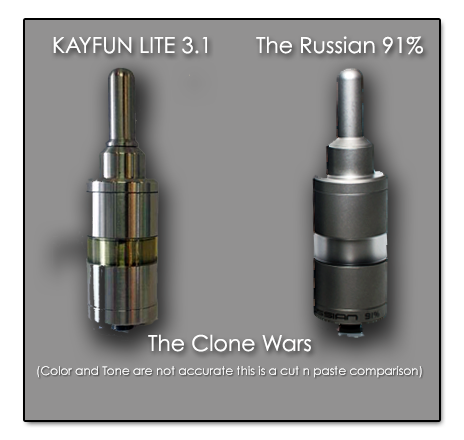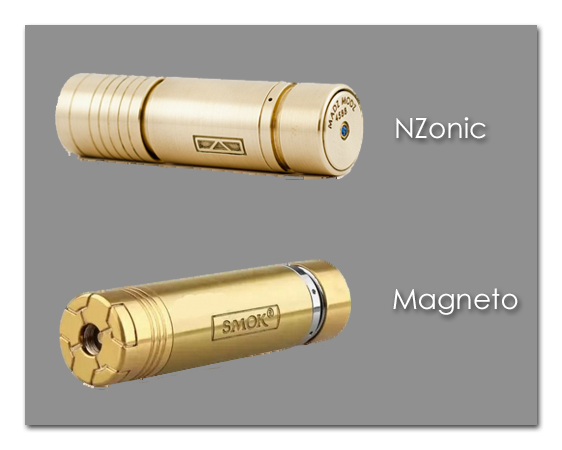Table of Contents
(Because “The Clone Wars” was too obvious…)
Are Clones and Knockoffs the same?
Should we buy them? And finally, should we even care?
Introduction
Could there be a more hotly debated issue than the vape mod clone issue? If there is, I have yet to encounter it. There is so much involved in the issue of clones, and I’m going to cover as much of it as I can, but I have this nagging feeling that I’m going to miss a key point or two. For that reason, I strongly encourage a healthy (but respectful) debate in the comments.
To begin with, what is a vape mod “clone”? Why are they such a contentious topic? Should you buy devices — such as mechanical mods and rebuildable atomizers — that you know are clones? And if you do, how do you know which ones are actually good and which ones are junk? Those are the questions I’m going to do my level best to answer for you today.
Clones
Let me first begin by offering my personal definition of what constitutes a “clone”; I think my definition is at least fairly close to the most commonly understood and accepted definition: A clone is a piece of vaping hardware that is a point-by-point third-party rendition of the original developer’s design. To illustrate, allow me to draw your attention to a couple of examples, one of which is very definitely a clone, and the other of which is a little more fuzzy but for which a strong argument of clone status could be made:
The first is the comparison between the SvoeMesto-designed Kayfun Lite and a very popular clone known as The Russian 91%.
 Can you tell which one is which without leaning in real close and giving each on the eagle eye? More importantly, if somebody handed you one without telling you which it was, would you be able to tell the difference from their performance? That, really, is the key question, and the answer to that question is what determines whether you’re dealing with a clone or something much, much worse — a knockoff.
Can you tell which one is which without leaning in real close and giving each on the eagle eye? More importantly, if somebody handed you one without telling you which it was, would you be able to tell the difference from their performance? That, really, is the key question, and the answer to that question is what determines whether you’re dealing with a clone or something much, much worse — a knockoff.
Clones typically duplicate the devices that inspire them so closely that they use not only the same (or substantially similar) overall design and details, but in many cases also use the same materials. What this leads to is a piece of hardware that not only looks like a much more expensive original, but performs on par with that original, as well.
(Note* These photo collages were constructed to illustrate the similaraties between these four popular products, despite only two of them being “the real deal”, as it were. Color, light sources, and even scale were tweaked as well as time allowed. If you need more photographic evidence search Google or Bing, there are hundreds. – Dave)
But there are relative degrees of how close something is to another device, how clearly it either is or isn’t a clone. I have heard and read that, while it may or may not qualify as a clone in the opinions of many, the Smoktech Magneto was, at least, “strongly inspired by” the Madz Modz NZonic mechanical mod. While the exterior cosmetic touches are just different enough, in my opinion, to keep the Magneto just one step from clone status — as seen here:
— It’s the cosmetic similarity in conjunction with the Magneto’s introduction of the magnetic firing switch to the sub-$100 mechanical mod market that keep that clone status well within arm’s reach.
But, to reiterate that earlier point: both The Russian 91% and the Smoktech Magneto are, by all accounts, amazing pieces of hardware in their own right. Despite the fact that cloned designs are, essentially, reproductions of more expensive hardware, they are made to perform on par with the products they are imitations of. But there is another class of imitation hardware out there whose manufacturers are not similarly dedicated to delivering high quality at lower prices. I distinguish this lesser class of imitators as knockoffs. And you need to know about them.
Knockoffs
So what is the chief difference between a clone and a knockoff? How do you tell which one you’re dealing with, at a glance? Well, there’s the problem. At a glance, you can’t. Not reliably, anyway. But I have devised a few best practices that should help you avoid them.
1. Mechanical mods and rebuildable atomizers are by far the most cloned pieces of hardware in the industry. They are, commensurately, also the most copied by cheap knockoff artists. Therefore,
2. Know your vendor. If you’re looking for a clone, get it from a well known seller. Research it. Look for reviews, both of the hardware you intend to buy and of the place that’s selling it.
3. If you can, look at the guts. While many knockoffs look identical, or at minimum very similar, to the originals on the exterior, their cheap junk nature will be revealed pretty quickly on the interior. Let me break from the list and tell you a story that illustrates this point.
The very first RBA I ever purchased was (not) a Smoktech “Octopus” Mini. I was still using my very first VV device, the iTaste version 1, and a new “vape shop” had just opened down the street. Knowing nearly nothing about rebuildable atomizers other than that I really wanted to learn how to build and use them, I decided to drop $15 on this one. (Also not aware that that’s about twice what the thing should cost…)
Well, I had a look inside it and discovered that it sold with a pre-built coil. Wonderful. So off I went, a happy camper. I got home, dripped about 5 drops of eliquid onto the coil and put a drip tip on it. I let it sit for about 5 minutes, and then had a vape. Rather, I tried and failed to vape it. The issue was that there was no airflow. I thought that was odd, so I spent about an hour searching online until I found the atomizer mine was supposed to be.
The first image I saw clearly showed that there was a hole for airflow in the top cap. I looked at mine. Then I looked some more. My RBA had no airflow hole in the top cap. I watched a video on the Octopus, and saw that the top cap could be lifted right off the deck. I tried to lift the top cap off mine. No joy. I eventually resorted to a pair of pliers in each hand, and it took all the elbow grease I had to pull the top cap off.
The Smoktech Octopus and Octopus Mini use tool-less thumbscrews on the positive and negative posts. The one in my hands used Philips head screws. And had no airflow. I had been sold a piece of cheap garbage at twice what the genuine article costs. Which brings me to Point #4 on the list:
4. Research the ever loving **** out of the device you want to buy before your hand even touches your wallet.
And now, because I know people are wondering about this…
The Ethics Of Clone Hardware
What are the ethics of making — or, for the rest of us, purchasing — clones? What are the consequences of hardware cloning? Should we even be worried about either the ethics or the consequences of hardware cloning?
I’m going to state the best and worst case ethical consequences of hardware cloning, but before I do that, let me assure you of this: I, personally, can see the validity of portions of both ethical positions on this subject. Both those who are for it and those who are against it have valid, logical points to support their positions, and the last thing I want is to spark any kind of hostility between the two camps. I encourage discussion and even debate, as long as it’s civil, respectful, and based on reason and a desire to seek and achieve common ground.
With all that said, here is the worst case scenario of hardware cloning:
Innovation in hardware design suffers and slows down. Let’s say I create a rebuildable atomizer that I can fill by waving it over whatever flavor of eliquid I want; the atomizer then uses forced induction to pull that flavor from the air, condenses the air, infuses the liquid with nicotine from leprechaun farts, and voila — a self-refilling rebuildable atomizer. (Yes, that’s a bit tongue-in-cheek, just using it to describe “a new miracle hardware”…)
But because I know that it will be cloned and I’ll lose out on sales, I keep it all to myself and never release it to the vaping public. There’s the potential negative consequence of hardware cloning, that it may actually have a stifling effect on hardware design innovation. There may be designers out there who are sitting on simply amazing innovations, fretful that once they are brought to market, they’ll simply be copied and well-deserved sales, not to mention recognition, will be denied to the person who came up with the brilliant new idea.
And now let me contrast that with the best case scenario:
Let’s say I build that same miracle atomizer and bring it to market. I know it’ll be cloned, but here’s what I do — I release it, at first, to only a very limited selection of resellers. I create special editions. I keep the first release extremely limited in number. I build prestige around owning the original. At the same time, I continue to innovate. Oh, yes, the clones are out there, but even as people are enjoying the clone — which makes the entire vaping community better for having the feature widely available, my version, the original, is the one people really long for, because it will achieve the exclusivity and prestige of a status symbol.
Similarly, even people who have, and love, The Russian are still likely to long for a Kayfun. I know that I can say, personally and truthfully, that while I love my Magneto, I would love to buy an NZonic. Are the originals functionally superior to the clones? Probably not by wide margins. But do the originals possess a certain prestige, in part due to the fact that they were so good that they were cloned? Absolutely.
Which scenario is the one that real results are trending toward? I suspect there’s a little of both going on. If any of you know with relative certainty, please let me know in the comments.
Conclusion
I hope that this piece has given you a glimpse of something that, while it’s been right under most of our noses, hasn’t really been obvious to all of us. I hope that you can use the guidelines I’ve given you, going forward, in your hardware selection, and that you’ll be able to steer clear of the knockoffs while finding the best deals out there. Thanks for reading, and don’t hesitate to bring your comments or questions.
John Castle






